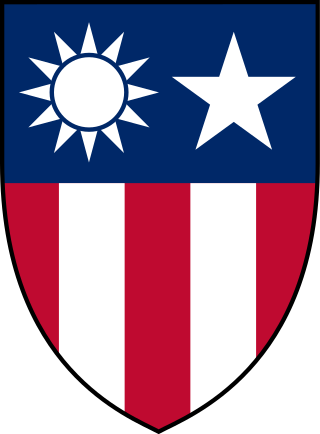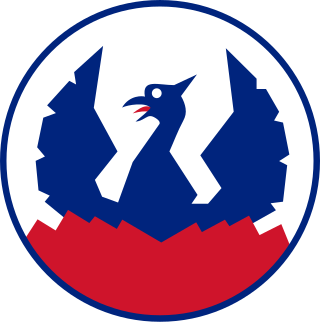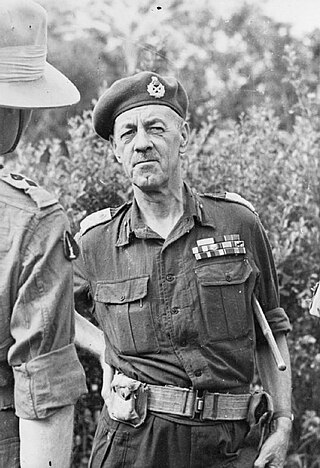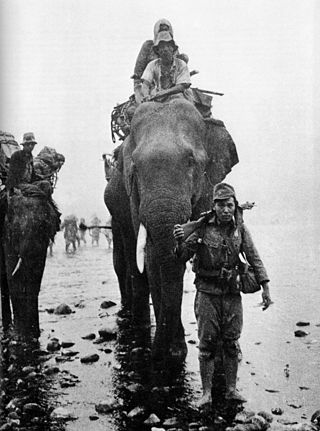Related Research Articles

The Chindits, officially known as Long Range Penetration Groups, were special operations units of the British and Indian armies which saw action in 1943–1944 during the Burma Campaign of World War II.

The British Fourteenth Army was a multi-national force comprising units from Commonwealth countries during the Second World War. As well as British Army units, many of its units were from the Indian Army and there were also significant contributions from the British Army's West and East African divisions. It was often referred to as the "Forgotten Army" because its operations in the Burma campaign were overlooked by the contemporary press, and remained more obscure than those of the corresponding formations in Europe for long after the war. For most of the Army's existence, it was commanded by Lieutenant-General William Slim.

The Burma campaign was a series of battles fought in the British colony of Burma. It was part of the South-East Asian theatre of World War II and primarily involved forces of the Allies against the invading forces of the Empire of Japan. Imperial Japan was supported by the Thai Phayap Army, as well as two collaborationist independence movements and armies. Nominally independent puppet states were established in the conquered areas and some territories were annexed by Thailand. In 1942 and 1943, the international Allied force in British India launched several failed offensives to retake lost territories. Fighting intensified in 1944, and British Empire forces peaked at around 1 million land and air forces. These forces were drawn primarily from British India, with British Army forces, 100,000 East and West African colonial troops, and smaller numbers of land and air forces from several other Dominions and Colonies. These additional forces allowed the Allied recapture of Burma in 1945.

China Burma India Theater (CBI) was the United States military designation during World War II for the China and Southeast Asian or India–Burma (IBT) theaters. Operational command of Allied forces in the CBI was officially the responsibility of the Supreme Commanders for South East Asia or China. In practice, U.S. forces were usually overseen by General Joseph Stilwell, the Deputy Allied Commander in China; the term "CBI" was significant in logistical, material and personnel matters; it was and is commonly used within the US for these theaters.

The Battle of Kohima was the turning point of the Japanese U-Go offensive into India in 1944 during the Second World War. The battle took place in three stages from 4 April to 22 June 1944 around the town of Kohima, now the capital city of Nagaland in Northeast India. From 3 to 16 April, the Japanese attempted to capture Kohima ridge, a feature which dominated the road by which the besieged British and Indian troops of IV Corps at Imphal were supplied. By mid-April, the small British and British Indian force at Kohima was relieved.

The Battle of Imphal took place in the region around the city of Imphal, the capital of the state of Manipur in Northeast India from March until July 1944. Japanese armies attempted to destroy the Allied forces at Imphal and invade India, but were driven back into Burma with heavy losses. Together with the simultaneous Battle of Kohima on the road by which the encircled Allied forces at Imphal were relieved, the battle was the turning point of the Burma campaign, part of the South-East Asian theatre of World War II. The Japanese defeat at Kohima and Imphal was the largest up until that time, with many of the Japanese deaths resulting from starvation, disease and exhaustion suffered during their retreat. According to voting in a contest run by the British National Army Museum, the Battle of Imphal was bestowed as Britain's Greatest Battle in 2013.

Force 136 was a far eastern branch of the British World War II intelligence organisation, the Special Operations Executive (SOE). Originally set up in 1941 as the India Mission with the cover name of GSI(k), it absorbed what was left of SOE's Oriental Mission in April 1942. The man in overall charge for the duration of its existence was Colin Mackenzie.

The 5th Indian Infantry Division was an infantry division of the Indian Army during World War II that fought in several theatres of war and was nicknamed the "Ball of Fire". It was one of the few Allied divisions to fight against three different armies - the Italian, German and Japanese armies.

The Battle of the Admin Box took place on the southern front of the Burma campaign from 5 to 23 February 1944, in the South-East Asian Theatre of World War II.
The Chin Hills are a range of mountains in Chin State, northwestern Burma (Myanmar), that extends northward into India's Manipur state.

General Sir Geoffry Allen Percival Scoones, was a senior officer in the Indian Army during the Second World War.
The Lushai Brigade was an improvised fighting formation of the British Indian Army which was formed during World War II. It participated in the Battle of Imphal and the Burma Campaign.
No. 4 Squadron IAF (Oorials) is a fighter squadron of the Indian Air Force (IAF) equipped with the Su-30 MKI, based at Jodhpur Air Force Station in Jodhpur in, Rajasthan, India. Since its establishment during the South-East Asian theatre of World War II, No. 4 Squadron remains the only fighter squadron other than No. 3 Squadron IAF and No. 7 Squadron IAF to remain continuously in existence in the service of India.
The Battles and Operations involving the Indian National Army during World War II were all fought in the South-East Asian theatre. These range from the earliest deployments of the INA's preceding units in espionage during Malayan Campaign in 1942, through the more substantial commitments during the Japanese Ha Go and U Go offensives in the Upper Burma and Manipur region, to the defensive battles during the Allied Burma campaign. The INA's brother unit in Europe, the Indische Legion did not see any substantial deployment although some were engaged in Atlantic wall duties, special operations in Persia and Afghanistan, and later a small deployment in Italy. The INA was not considered a significant military threat. However, it was deemed a significant strategic threat especially to the Indian Army, with Wavell describing it as a target of prime importance.

The U Go offensive, or Operation C, was the Japanese offensive launched in March 1944 against forces of the British Empire in the northeast Indian regions of Manipur and the Naga Hills. Aimed at the Brahmaputra Valley, through the two towns of Imphal and Kohima, the offensive along with the overlapping Ha Go offensive was one of the last major Japanese offensives during the Second World War. The offensive culminated in the Battles of Imphal and Kohima, where the Japanese and their allies were first held and then pushed back.

The Burma campaign in the South-East Asian Theatre of World War II took place over four years from 1942 to 1945. During the first year of the campaign, the Imperial Japanese Army with aid from Burmese insurgents had driven British forces and Chinese forces out of Burma, and occupied most of the country. From May to December 1942, most active campaigning ceased as the monsoon rains made tactical movement almost impossible in the forested and mountainous border between India and Burma, and both the Allies and Japanese faced severe logistical constraints.

The fighting in the Burma campaign in 1944 was among the most severe in the South-East Asian Theatre of World War II. It took place along the borders between Burma and India, and Burma and China, and involved the British Commonwealth, Chinese and United States forces, against the forces of Imperial Japan and the Indian National Army. British Commonwealth land forces were drawn primarily from the United Kingdom, British India and Africa.

The Japanese Twenty-Eighth Army was an army of the Imperial Japanese Army during the final days of World War II.

The Arakan campaign of 1942–1943 was the first tentative Allied attack into Burma, following the Japanese invasion of Burma earlier in 1942, during the Second World War. The British Army and British Indian Army were not ready for offensive actions in the difficult terrain they encountered, nor had the civil government, industry and transport infrastructure of Eastern India been organised to support the Army on the frontier with Burma. Japanese defenders occupying well-prepared positions repeatedly repulsed the British and Indian forces, who were then forced to retreat when the Japanese received reinforcements and counter-attacked.
The Battle of Ramu, fought in May 1824, was one of the opening battles of the First Anglo-Burmese War. On May 10, 1824, the Burmese under General Maha Bandula launched an invasion of Chittagong from Arakan as the southern part of a two-pronged attack aimed at Calcutta. They offered to end the invasion if the British were to hand over some Arakanese rebels that had taken refuge in the Bengal Presidency. The British commander at Ramu, Captain Noton, rejected the offer, and the Burmese detachment under Lord Myawaddy Mingyi U Sa attacked. After three days of fighting the British troops, a mixed force with a total strength of several hundred men, was routed and forced from Ramu on May 17. The British losses in killed, wounded and missing amounted to more than half the strength of the garrison. The Burmese however failed to exploit their advantage, and Maha Bandula's army would withdraw to counter the British occupation of Rangoon.
References
This article includes a list of general references, but it lacks sufficient corresponding inline citations .(June 2009) |
- Allen, Louis (1984). Burma: The longest War. Dent Publishing. ISBN 0-460-02474-4.
- Bayly, Christopher; Harper, Tim (2005). Forgotten Armies. Penguin Books. ISBN 0-14-029331-0.
- Bowen, John (1978). Undercover In The Jungle. London: William Kimber. ISBN 0-7183-0226-5.
- Irwin, Anthony (1945). Burmese Outpost. London: Collins.
- Keane, Fergal (2010). Road of Bones: The Siege of Kohima 1944. London: HarperPress. ISBN 978-0-00-713240-9.
- Latimer, Jon (2004). Burma: The Forgotten War. London: John Murray. ISBN 0-7195-6576-6.